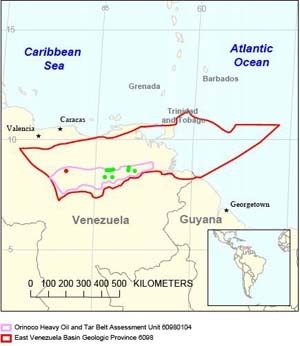Orinoco Heavy Oil Belt, Venezuela
Orinoco Heavy Oil Belt, Venezuela, (8° 22' 40.62N, 63° 28' 24.09W) is one of the world’s largest accumulations of natural bitumen and heavy oil. The Orinoco Heavy Oil Belt (or Faja del Orinoco) is located in the southern part of the Eastern Venezuelan Basin, to the north of the Orinoco River. It covers an area of 54,000 km2 in the Monagas, Anzoategui, and Guarico states.
Heavy oil is an asphaltic, dense (low API gravity), and viscous oil that is chemically characterized by its content of asphaltenes (very large molecules incorporating most of the sulfur and perhaps 90 percent of the metals in the oil). Although variously defined, the upper limit for heavy oil has been set at 22° API gravity and a viscosity of 100 centipoise (cP). Natural bitumen, also called tar sands or oil sands, shares the attributes of heavy oil but is even more dense and viscous. Natural bitumen is oil with viscosity greater than 10,000 cP. Bitumen and heavy oils contain more nitrogen, oxygen, sulfur compounds and heavy-metal contaminants than lighter crude oil.
Due to these properties, heavy oil and bitumen are considered a semi-solid hydrocarbon at reservoir temperatures, which means that they require heating to be converted into liquid form. They are more expensive to produce than conventional light oil because they must be refined to remove sulfur and other metals and diluted with natural gas liquids or light crude oil.
The original oil-in-place of the Orinoco Heavy Oil Belt has been estimated at about 1,200 billion barrels. Due to its high cost of extraction, the fraction of oil-in-place that is economically viable to extract is highly dependent on the state of extraction technology and oil prices. The first comprehensive evaluation studies of economically recoverable reserves that could be expected from the Orinoco belt were conducted by the Venezualan national oil company, Petróleos de Venezuela S.A. (PdVSA), in 1983. PdVSA concluded that about 22% of the 1,200 billion barrels in place could be recovered, and calculated a figure of 267 Gb (billion barrels) of reserves for the whole Orinoco belt. These estimates are based on existing extraction technologies that have recovery factors on the order of 5 to 10% of the hydrocarbons in place. Improved recovery techniques have the potential to raise those efficiences.
In the 1990's, testing of an emulsion mixture of 70% bitumen from Orinoco and 30% water with surfactant (Orimulsion, a registered trademark of of Bitúmenes Orinoco, S.A.) as a fuel source in electricity generation boilers was begun. This method of utilization has greater potential for environmental damage from air emissions than other alternative fuel sources, unless environmental controls are applied.
Petróleos de Venezuela S.A., the state corporation of Venezuela, is in charge of the exploration, production, manufacturing, transportation, and negotiations of hydrocarbons. The marshy area that makes up the the delta region of the Orinoco River is rich in heavy oil resources, but is also home to many indigenous people and important ecosystems. PdVSA has acknowledged that the environment and the inhabitants will undoubtedly be affected by any efforts to drill or mine for oil, so a geo-environmental assessment of the Orinoco Delta has been conducted to ensure that development and exploration of the area can occur in a sustainable manner with minimal impact.
Further Reading
- Geo-Environmental Characterization of the Delta de Orinoco
- EIA Country Analysis Brief
- The Orinoco Heavy Oil Belt in Venezuela (or Heavy Oil to the Rescue?)
- Heavy Oil and Natural Bitumen -- Strategic Petroleum Resources
- What future for heavy oil and bitumen: the Orinoco case (Bauquis, Pierre-René, the World Energy Council, London, UK, retrieved April 30, 2006)
